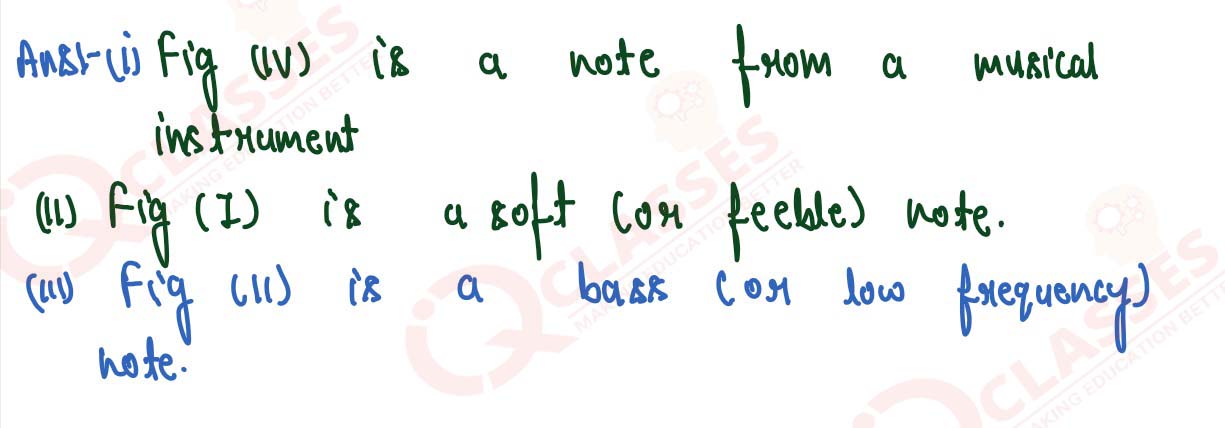Sound Chapter Mostlikely QuestionBank Class10 ICSE
Here we provide Class 10 Maths important notes,board questions and predicted questions with Answers for chapter Sound These important notes,board questions and predicted questions are based on ICSE board curriculum and correspond to the most recent Class 10 Maths syllabus. By practising these Class 10 materials, students will be able to quickly review all of the ideas covered in the chapter and prepare for the Class 10 Board examinations.
Class 10 ICSE Sound Mostlikely QuestionBank
Sound Mostlikely QuestionBank
Q1
State two applications of echo
solutions
solutions

Q2
What is 'SONAR'? State the principle on which it is based
solutions
solutions

Q3
A man standing 25 m away from a wall produces a sound and receives the reflected
sound. (a) Calculate the time after which he receives the reflected sound if the speed
of sound in air is 350 m/s-1. (b) Will the man be able to hear a distinct echo? Explain
the answer.
solutions

solutions


Q4
A person standing at a distance x in front Of a cliff fires a gun. Another person B
standing behind the person A at a distance y from the cliff hears two sounds of the
fired shots after 2s and 3s respectively. Calculate x and y (take speed of sound 320
ms-1)
solutions


solutions



Q5
Figure below shows the distance-displacement graph of two waves A and B.
Compare (i) the amplitude, (ii) the wavelength of the two waves.

solutions

Compare (i) the amplitude, (ii) the wavelength of the two waves.

solutions


Q6
The diagram below in Fig. shows three ways in which the string Of an instrument
can vibrate.

(a)Which Of the diagram shows the principal note?
(b)Which vibration has the frequency four times that of the first?
(c) Which vibration is Of longest wavelength?
(d)What is the ratio of the frequency of vibrations in diagram (i) and (ii)?
solutions

(a)Which Of the diagram shows the principal note?
(b)Which vibration has the frequency four times that of the first?
(c) Which vibration is Of longest wavelength?
(d)What is the ratio of the frequency of vibrations in diagram (i) and (ii)?
solutions

Q7
How does the medium affect the amplitude of the natural vibrations of a body
solutions
solutions

Q8
The diagram in figure shows the displacement—time graph Of a vibrating body.

(i) Name the kind of vibrations.
(ii) Give one example of such vibration.
(iii) Why is the amplitude of vibrations gradually decreasing?
(iv) What happens to the vibrations Of the body after sometime?
solutions


(i) Name the kind of vibrations.
(ii) Give one example of such vibration.
(iii) Why is the amplitude of vibrations gradually decreasing?
(iv) What happens to the vibrations Of the body after sometime?
solutions


Q9
State the difference between the force and resonant vibrations
solutions
solutions

Q10
In figure A, B, C and D are the four pendulums suspended from the same elastic
string XY. The lengths of pendulum A and I) are equal, while the length of
pendulum B is shorter and Of the pendulum C is longer. The pendulum A is set into
vibrations.
(a) What is your observation about the vibrations of pendulum D?
(b) Give reason for your observation in part (a).
(c) What type of vibrations take place in pendulums B and C?
(d) Give reason for the answer in part (c)

solutions



(a) What is your observation about the vibrations of pendulum D?
(b) Give reason for your observation in part (a).
(c) What type of vibrations take place in pendulums B and C?
(d) Give reason for the answer in part (c)

solutions




Q11
When a troop crosses a suspension bridge,the soldiers are asked to break their steps.Why?
solutions

solutions


Q12
(a)Which Of the following quantity determines the loudness Of a sound wave?
(i)Wavelength
(ii) frequency and
(iii) amplitude
(b)How is loudness related to the quantity mentioned in above part (a)
solutions
(i)Wavelength
(ii) frequency and
(iii) amplitude
(b)How is loudness related to the quantity mentioned in above part (a)
solutions

Q13
Two waves or the same pitch have amplitudes in the ratio 1:3. What will be the ratio
of their (i) loudness (ii) frequencies?
solutions
solutions

Q14
The diagram below shows three different modes Of vibration P, Q and R Of the same
string of a givens length.

(a) Which vibration will produce a louder sound and why?
(b) Which vibration will produce sound of maximum shrillness (or pitch) and why?
(c) What is the ratio of wavelength of vibrations P and R?
solutions

(a) Which vibration will produce a louder sound and why?
(b) Which vibration will produce sound of maximum shrillness (or pitch) and why?
(c) What is the ratio of wavelength of vibrations P and R?
solutions

Q15
Two musical notes Of the same pitch and same loudness are played on two different
instruments. Their wave patterns are as shown in the diagram below.

Explain why the wave patterns are different.
solutions

Explain why the wave patterns are different.
solutions

Q16
Which characteristic of sound makes it possible to recognise a person by his voice
without seeing him?
solutions
solutions

Q17
The sketches I to IV in figure show sound waves, all formed in the same time
interval.

Which diagram shows
(i) a note from a musical instrument,
(ii) a soft (or feeble) note,
(iii) a bass (or low frequency) note.
solutions

Which diagram shows
(i) a note from a musical instrument,
(ii) a soft (or feeble) note,
(iii) a bass (or low frequency) note.
solutions

Q18
Shows the wave patterns of three sounds A, B and C. Name the characteristic of
sound which is same between (i) A and B, (ii) B and C, and (iii) C and A

solutions

solutions

Q19
State one difference between a musical note and a noise
solutions
solutions


Reach Us
SERVICES
- ACADEMIC
- ON-LINE PREPARATION
- FOUNDATION & CRASH COURSES
CONTACT
B-54, Krishna Bhawan, Parag Narain Road,
Near Butler Palace Colony Lucknow
Contact:+918081967119

Add a comment